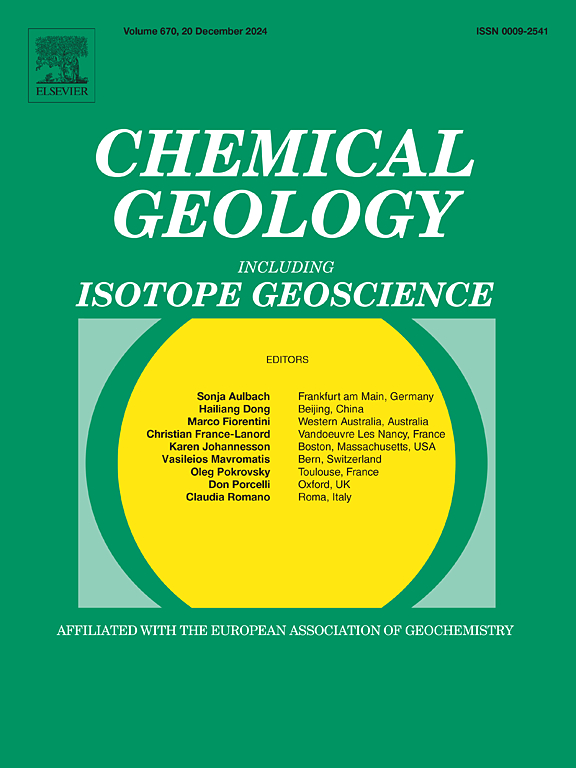Structural and transport properties of supercritical NaAlSi3O8-H2O fluids: Insight from ReaxFF molecular dynamics simulations
IF 3.6
2区 地球科学
Q1 GEOCHEMISTRY & GEOPHYSICS
引用次数: 0
Abstract
With intermediate compositions between hydrous fluids and silicate melts, supercritical fluids are ideal agents for mass transfer from the subducting slab into the mantle wedge with fluid-like viscosity and melt-like elemental carrying capacity. However, the structure and transport properties of supercritical fluid have not been well understood. In this study, we investigated the structure and transport properties of supercritical NaAlSi3O8-H2O systems by using the ReaxFF reactive molecular dynamics technique at 1000–3000 K and ∼ 2 GPa. The effect of water content and temperature on speciation, structure, diffusivity, and viscosity of supercritical fluids was explored. Si is primarily 4-coordinated, while Al exhibits coordination numbers of 3 to 6. As water content increases, Q4 and Q5 species decrease and Q0 species increase continuously, while the dominant species progressively transition from Q4 to Q3, followed by Q2, Q1, Q0. The elemental diffusivity and viscosity were both modeled as a function of water content and temperature. These models can be useful for the prediction of transport properties of hydrous silicate melts/fluids. Overall, the findings presented in this study formed a molecular level understanding of a typical supercritical fluid.
超临界NaAlSi3O8-H2O流体的结构和输运性质:来自ReaxFF分子动力学模拟的见解
超临界流体的成分介于含水流体和硅酸盐熔体之间,是俯冲板块向地幔楔体传质的理想介质,具有流体般的黏度和熔体般的元素承载能力。然而,人们对超临界流体的结构和输运性质还没有很好的认识。在这项研究中,我们利用ReaxFF反应分子动力学技术研究了超临界NaAlSi3O8-H2O体系在1000-3000 K和~ 2 GPa下的结构和输运性质。探讨了含水量和温度对超临界流体形态、结构、扩散率和粘度的影响。Si的配位数主要为4,而Al的配位数为3 ~ 6。随着含水量的增加,Q4和Q5种不断减少,Q0种不断增加,优势种由Q4逐步过渡到Q3,其次是Q2、Q1、Q0。元素扩散系数和粘度都是水含量和温度的函数。这些模型可用于预测含水硅酸盐熔体/流体的输运性质。总的来说,本研究的发现形成了对典型超临界流体的分子水平理解。
本文章由计算机程序翻译,如有差异,请以英文原文为准。
求助全文
约1分钟内获得全文
求助全文
来源期刊

Chemical Geology
地学-地球化学与地球物理
CiteScore
7.20
自引率
10.30%
发文量
374
审稿时长
3.6 months
期刊介绍:
Chemical Geology is an international journal that publishes original research papers on isotopic and elemental geochemistry, geochronology and cosmochemistry.
The Journal focuses on chemical processes in igneous, metamorphic, and sedimentary petrology, low- and high-temperature aqueous solutions, biogeochemistry, the environment and cosmochemistry.
Papers that are field, experimentally, or computationally based are appropriate if they are of broad international interest. The Journal generally does not publish papers that are primarily of regional or local interest, or which are primarily focused on remediation and applied geochemistry.
The Journal also welcomes innovative papers dealing with significant analytical advances that are of wide interest in the community and extend significantly beyond the scope of what would be included in the methods section of a standard research paper.
 求助内容:
求助内容: 应助结果提醒方式:
应助结果提醒方式:


